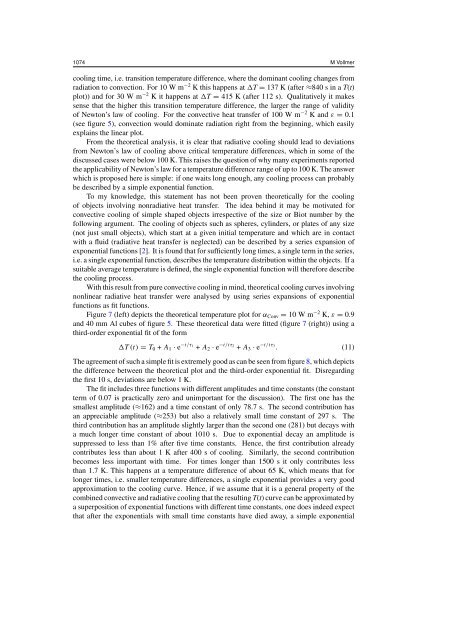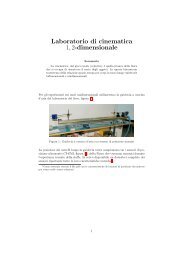Newton's law of cooling revisited - Cartan
Newton's law of cooling revisited - Cartan
Newton's law of cooling revisited - Cartan
You also want an ePaper? Increase the reach of your titles
YUMPU automatically turns print PDFs into web optimized ePapers that Google loves.
1074 M Vollmer<br />
<strong>cooling</strong> time, i.e. transition temperature difference, where the dominant <strong>cooling</strong> changes from<br />
radiation to convection. For 10 W m −2 K this happens at �T = 137 K (after ≈840 s in a T(t)<br />
plot)) and for 30 W m −2 K it happens at �T = 415 K (after 112 s). Qualitatively it makes<br />
sense that the higher this transition temperature difference, the larger the range <strong>of</strong> validity<br />
<strong>of</strong> Newton’s <strong>law</strong> <strong>of</strong> <strong>cooling</strong>. For the convective heat transfer <strong>of</strong> 100 W m −2 K and ε = 0.1<br />
(see figure 5), convection would dominate radiation right from the beginning, which easily<br />
explains the linear plot.<br />
From the theoretical analysis, it is clear that radiative <strong>cooling</strong> should lead to deviations<br />
from Newton’s <strong>law</strong> <strong>of</strong> <strong>cooling</strong> above critical temperature differences, which in some <strong>of</strong> the<br />
discussed cases were below 100 K. This raises the question <strong>of</strong> why many experiments reported<br />
the applicability <strong>of</strong> Newton’s <strong>law</strong> for a temperature difference range <strong>of</strong> up to 100 K. The answer<br />
which is proposed here is simple: if one waits long enough, any <strong>cooling</strong> process can probably<br />
be described by a simple exponential function.<br />
To my knowledge, this statement has not been proven theoretically for the <strong>cooling</strong><br />
<strong>of</strong> objects involving nonradiative heat transfer. The idea behind it may be motivated for<br />
convective <strong>cooling</strong> <strong>of</strong> simple shaped objects irrespective <strong>of</strong> the size or Biot number by the<br />
following argument. The <strong>cooling</strong> <strong>of</strong> objects such as spheres, cylinders, or plates <strong>of</strong> any size<br />
(not just small objects), which start at a given initial temperature and which are in contact<br />
with a fluid (radiative heat transfer is neglected) can be described by a series expansion <strong>of</strong><br />
exponential functions [2]. It is found that for sufficiently long times, a single term in the series,<br />
i.e. a single exponential function, describes the temperature distribution within the objects. If a<br />
suitable average temperature is defined, the single exponential function will therefore describe<br />
the <strong>cooling</strong> process.<br />
With this result from pure convective <strong>cooling</strong> in mind, theoretical <strong>cooling</strong> curves involving<br />
nonlinear radiative heat transfer were analysed by using series expansions <strong>of</strong> exponential<br />
functions as fit functions.<br />
Figure 7 (left) depicts the theoretical temperature plot for αConv = 10 W m −2 K, ε = 0.9<br />
and 40 mm Al cubes <strong>of</strong> figure 5. These theoretical data were fitted (figure 7 (right)) using a<br />
third-order exponential fit <strong>of</strong> the form<br />
�T (t) = T0 + A1 · e −t/τ1 + A2 · e −t/tτ2 + A3 · e −t/tτ3 . (11)<br />
The agreement <strong>of</strong> such a simple fit is extremely good as can be seen from figure 8, which depicts<br />
the difference between the theoretical plot and the third-order exponential fit. Disregarding<br />
the first 10 s, deviations are below 1 K.<br />
The fit includes three functions with different amplitudes and time constants (the constant<br />
term <strong>of</strong> 0.07 is practically zero and unimportant for the discussion). The first one has the<br />
smallest amplitude (≈162) and a time constant <strong>of</strong> only 78.7 s. The second contribution has<br />
an appreciable amplitude (≈253) but also a relatively small time constant <strong>of</strong> 297 s. The<br />
third contribution has an amplitude slightly larger than the second one (281) but decays with<br />
a much longer time constant <strong>of</strong> about 1010 s. Due to exponential decay an amplitude is<br />
suppressed to less than 1% after five time constants. Hence, the first contribution already<br />
contributes less than about 1 K after 400 s <strong>of</strong> <strong>cooling</strong>. Similarly, the second contribution<br />
becomes less important with time. For times longer than 1500 s it only contributes less<br />
than 1.7 K. This happens at a temperature difference <strong>of</strong> about 65 K, which means that for<br />
longer times, i.e. smaller temperature differences, a single exponential provides a very good<br />
approximation to the <strong>cooling</strong> curve. Hence, if we assume that it is a general property <strong>of</strong> the<br />
combined convective and radiative <strong>cooling</strong> that the resulting T(t) curve can be approximated by<br />
a superposition <strong>of</strong> exponential functions with different time constants, one does indeed expect<br />
that after the exponentials with small time constants have died away, a simple exponential




